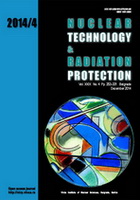
BURNUP SIMULATIONS OF DIFFERENT FUEL GRADES USING THE MCNPX MONTE CARLO CODE

Vol.
XXIX, No. 4, Pp. 253-331
December 2014
UDC 621.039+614.876:504.06
ISSN 1451-3994
Pages: 259-267
Authors: Fiifi Asah-Opoku, Zhihua Liang, Ziaul Huque, and Raghava R. Kommalapati
Abstract
Global energy problems range from the increasing cost of fuel to the unequal distribution of energy resources and the potential climate change resulting from the burning of fossil fuels. A sustainable nuclear energy would augment the current world energy supply and serve as a reliable future energy source. This research focuses on Monte Carlo simulations of pressurized water reactor systems. Three different fuel grades – mixed oxide fuel (MOX), uranium oxide fuel (UOX), and commercially enriched uranium or uranium metal (CEU) – are used in this simulation and their impact on the effective multiplication factor (Keff) and, hence, criticality and total radioactivity of the reactor core after fuel burnup analyzed. The effect of different clad materials on Keff is also studied. Burnup calculation results indicate a buildup of plutonium isotopes in UOX and CEU, as opposed to a decline in plutonium radioisotopes for MOX fuel burnup time. For MOX fuel, a decrease of 31.9% of the fissile plutonium isotope is observed, while for UOX and CEU, fissile plutonium isotopes increased by 82.3% and 83.8%, respectively. Keff results show zircaloy as a much more effective clad material in comparison to zirconium and stainless steel.
Key words: MCNPX code, burnup calculation, criticality calculation, radionuclide inventory
FULL PAPER IN PDF FORMAT (1.54 MB)